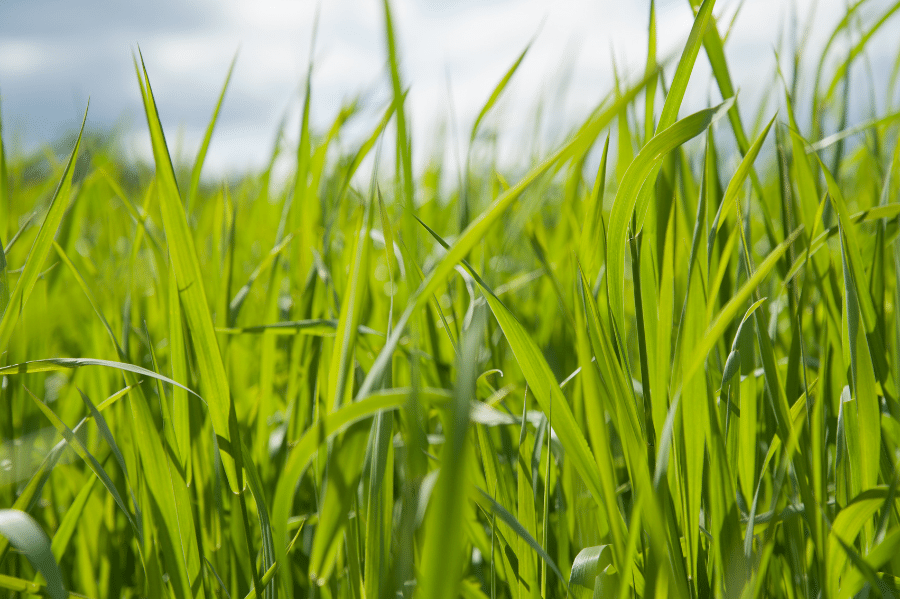Everyone wants a lush, green lawn!
Having healthy grass looks great and makes the rest of your yard look even better.
Frequent mowing is commonly touted as a quick and straightforward method to thicken grass, but does it work?
Frequent mowing thickens grass by trimming only the tips off of each grass blade. The hormones in the tips prevent grass from growing and spreading. Cutting them often promotes the overall growth and spread of the grass and helps it grow back thicker and stronger towards the roots.
Read on to learn more about how often you should mow to thicken your grass and how this simple yet effective method promotes grass growth.

Table of Contents
Will Mowing More Often Thicken Grass?
Regardless of your lawn’s grass types, mowing often will help thicken your grass and promote your lawn’s health and growth in general.
Inside each blade of grass are hormones that prevent the grass from growing beyond a certain length and prevent it from spreading horizontally, too.
Mowing and trimming the tips of the grass will encourage it to grow back thicker and fuller and encourage horizontal growth, so it spreads to cover bare spots in your yard.
In addition, grass grows back much faster when it’s cut often.
When a blade of grass is cut, it will quickly compensate by growing back faster to restore itself.
Essentially, mowing your lawn sends signals to the grass to produce more grass more quickly.
You’ll also find far fewer pests feeding on and otherwise destroying your lawn if you mow regularly and often!
Mowing will quickly eliminate a potentially growing insect infestation and keep pests in check.
How Often Should You Mow?
While mowing often promotes a healthier lawn overall, it’s just as important not to overdo it!
There’s no set-in-stone rule for how often you should mow, though, since everyone’s lawn is different, and the environmental conditions for your lawn are going to be unique to where you live, the type of grass used, and many other factors.
As a general rule, you never want to have to remove more than ⅓ of the height of your grass at any given time, and you want to be sure to leave at least 2″ inches of growth behind after mowing, regardless of the type of grass in your yard.
Trimming too much grass height too often will leave your yard more prone to damage from the sun or weed growth, and your grass won’t have enough time to breathe and grow back correctly.
Additionally, cutting your grass too low will prevent it from photosynthesizing correctly, resulting in a patchy, yellow, and overall damaged lawn.
This is why it’s essential to get to know how quickly your grass grows so you will be able to better determine when you should mow.
In general, mowing once every 2 weeks or so is recommended.
However, this will vary significantly depending on the condition of your yard, type of grass, how well it is fertilized, the season, and more.
It’s best to simply mow your grass down to around 2″ inches, never trim more than ⅓ of its length at any given time, and determine how long it takes to grow back.
From there, you’ll be able to get a better idea of how much mowing your lawn demands and the optimal mowing height you should use.
Check out our full guide on how often you should mow grass for more details.
Tips When Mowing To Thicken Grass Fast

Mowing regularly and often isn’t the only way to thicken your grass and keep it growing back stronger.
There are many other factors to keep in mind, such as the direction in which you mow, the condition of the grass when you cut it, and plenty of other similar maintenance tips to keep your lawn thick and green, which we’ll cover in the following few sections.
Here is a handful of some of our best tips you should always follow whenever you pull your lawnmower out of the garage or shed to ensure a healthy, lush lawn for years to come.
Only Mow When Your Grass Is Dry
If you want thicker, greener grass, be sure to never mow when your yard is wet.
You’ll get an uneven cut if you mow when your grass is soaked, as the individual blades tend to stick and clump together.
Some of the blades of grass will simply bend due to the excess water weight when you go over it with the mower, meaning some sections won’t get cut at all.
Plus, the uneven, clumpy, wet clippings are more likely to clog your mower, meaning you’ll spend more time cleaning them out, making the whole ordeal more tedious and time-consuming.
Only mow your lawn when it’s nice and dry!
Proper mowing goes a long way when it comes to thickening your lawn.
Get Rid Of Debris and Weeds Before Mowing
Before every mow, be sure to rake your yard or go over it with something like a leaf vacuum to remove debris like dead leaves, pine needles, previous grass clippings, weeds, and whatever other organic matter might get in the way while mowing.
This debris will suffocate your grass and prevent healthy growth, so going over your lawn before a mow is a key part of proper lawn maintenance.
Aside from just keeping your lawn healthy and strong, getting rid of unsightly debris before mowing also makes it look better, brighter, and thicker.
Most importantly, it makes the whole mowing process a lot faster and easier than if you were to stop and remove debris individually as you go.
We have a post covering our tips for removing pine needles from your lawn if you want to check that out and hopefully it will make things a little easier for you.
Aerate Your Soil Often
Making sure your soil is properly aerated will go a long way in maintaining a healthier and thicker lawn.
Overly compacted, dense, and dry soil will prevent proper grass growth, and aeration is one of the fastest and easiest ways to help your soil “breathe.”
There are two main types of soil aeration: core aeration and spike aeration.
Both have their benefits and downsides, so you’ll have to choose what is best for your lawn and preferences.
Core aerating with a lawn aerator just pokes holes in the soil and removes tiny plugs or “cores” of soil, and deposits them on top of the grass, in turn stimulating growth and encouraging the movement of water and nutrients through the soil.
It also prevents thatch from building up and helps to control weed growth.
There’s also spike aeration, which is as simple as driving short spikes into the soil, usually with a rotating tool covered in said spikes.
It isn’t as effective as core aeration, but it’ll still help prevent your soil from becoming compacted.
Regardless of which method you choose, just be sure to aerate in between mows to promote thicker grass growth and a more beautiful lawn in general.
Learn more in our detailed guide for how to aerate your lawn.
Alternate Mowing Patterns
Another great tip for thickening your grass is to never mow in the same direction every single time.
Because grass typically grows in whatever direction it was mowed previously, alternating your mowing pattern will encourage your grass to grow back healthier and straighter.
By mowing in a different direction or pattern every time, your grass will grow back more upright rather than leaning over in a singular direction.
If you mow in the same pattern and direction every time, your grass will look shorter, more worn out, and less healthy overall.
Make Sure Your Mower Blades Are Sharp
A key factor in mowing properly to encourage thick, healthy grass is always maintaining sharp mower blades.
Dull blades simply won’t cut cleanly and evenly, resulting in torn, uneven grass.
Additionally, the torn, damaged grass will be more susceptible to damage from insects and diseases.
As a general rule, it’s best to sharpen your current mower blades every two to four months to keep them sharp and cut properly.
Exactly how often you sharpen them will vary depending on many factors, including the size of your yard and the frequency at which you mow it.
Don’t Scalp Your Lawn!
Above all, be sure to never mow your lawn too low or too frequently.
Cutting it too often or too low opens up your yard to all kinds of damage, from inviting weeds and pests into your lawn to making the grass prone to sun damage during dry spells.
Your grass needs at least a couple of inches of length at all times to stay healthy, and constantly keeping it far too short will turn it yellow and get it eaten up by weeds and insects.
It also won’t have enough length to spread horizontally throughout your yard, resulting in lots of bald patches all over your lawn over time.
While there is no one-size-fits-all mowing schedule, be sure to never cut more than ⅓ of your grass’ length at any given time.
Keeping your grass at around 2″ inches in height will also give it enough length to stay healthy and strong.
Take your time when mowing–don’t rush the process, and check the length as you go to make sure you aren’t trimming it beyond what it can grow back.